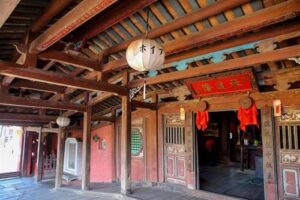Hoi An is an ancient Vietnamese city, located downstream of the Thu Bon River confluence, in the coastal plain of Quang Nam province, about 30 km south of Da Nang city. Hoi An used to be known in the international market by many different names such as Lam Ap, Faifo, Hoai Pho and Hoi An.
As a traditional port town of Southeast Asia, Hoi An retains almost intact more than 1,000 architectural relics of streets, houses, assembly halls, communal houses, pagodas, shrines, clan temples, ancient wells, ancient tombs, … The architecture not only has traditional Vietnamese artistic nuances, but also represents exchange and integration with the cultures of Eastern and Western countries. Over many centuries, traditional customs, activities, rituals, beliefs, and cuisine have been preserved and preserved with many generations of people in the old town. Hoi An also has a fresh, peaceful natural environment with lovely small suburban villages, with crafts such as carpentry, bronze, pottery,…

Researchers believe that the ancient architecture in Hoi An was mostly rebuilt in the early 19th century, although the year of construction may be much older. Ancient architecture is most clearly shown in the old town, located entirely within the area of Minh An ward. The old town has an area of about 2 km2, concentrating most of the famous relics in Hoi An: The streets in the old town are short and narrow, winding, running horizontally and vertically in a checkerboard style. The terrain of the old town is gradually inclined from north to south. The architectural works in the old town are built mostly with traditional materials “Bricks, wood and no houses are more than two floors. Visitors can easily recognize traces of time not only in the architectural style of each buildings, which are everywhere: On yin-yang tiled roofs covered with wind and plants, old, moldy gray walls, carvings of a strange animal or depicting an ancient story. … This place has attracted many talented artisans in carpentry, masonry, and ceramics from the Chinese, Japanese, and Cham people, so each project left behind is imprinted with a diverse and stylish culture. wealth of many nations.

For many centuries, Hoi An has been a place to meet, trade, and exchange many different cultures around the world. Besides the indigenous customs and practices of the Vietnamese people, there are also the customs of the foreign resident community, including the clearest cultural imprints of the Chinese and Japanese people.
